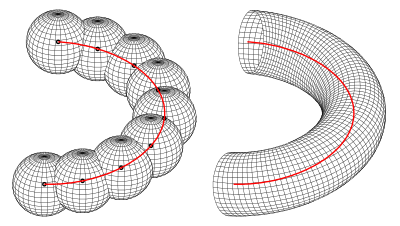Channel surface



A channel or canal surface is a surface formed as the envelope of a family of spheres whose centers lie on a space curve, its directrix. If the radii of the generating spheres are constant the canal surface is called pipe surface. Simple examples are:
- right circular cylinder (pipe surface, directrix is a line, the axis of the cylinder)
- torus (pipe surface, directrix is a circle),
- right circular cone (canal surface, directrix is a line (the axis), radii of the spheres not constant),
- surface of revolution (canal surface, directrix is a line),
Canal surfaces play an essential role in descriptive geometry, because in case of an orthographic projection its contour curve can be drawn as the envelope of circles.
- In technical area canal surfaces can be used for blending surfaces smoothly.
Envelope of a pencil of implicit surfaces
Given the pencil of implicit surfaces
- .
Two neighboring surfaces and intersect in a curve that fulfills the equations
- and .
For the limit one gets . The last equation is the reason for the following definition
- Let be a 1-parameter pencil of regular implicit - surfaces ( is at least twice continuously differentiable). The surface defined by the two equations
is the envelope of the given pencil of surfaces.[1]
Canal surface
Let be a regular space curve and a -function with and . The last condition means that the curvature of the curve is less than that of the corresponding sphere.
The envelope of the 1-parameter pencil of spheres
is called canal surface and its directrix. If the radii are constant, it is called pipe surface.
Parametric representation of a canal surface
The envelope condition
- ,
of the canal surface above is for any value of the equation of a plane, which is orthogonal to the tangent of the directrix . Hence the envelope is a collection of circles. This property is the key for a parametric representation of the canal surface. The center of the circle (for parameter ) has the distance (s. condition above) from the center of the corresponding sphere and its radius is . Hence
where the vectors and the tangenten vector form an orthonormal basis, is a parametric representation of the canal surface.[2]
For one gets the parametric representation of a pipe surface:


Examples
- a) The first picture shows a canal surface with
- the helix as directrix and
- the radius function .
- The choice for is the following:
- .
- b) For the second picture the radius is constant:, i. e. the canal surface is a pipe surface.
- c) For the 3. picture the pipe surface b) has parameter .
- d) The 4. picture shows a pipe knot. Its directrix is a curve on a torus
- e) The 5. picture shows a Dupin cyclide (canal surface).
References
- ↑ Geometry and Algorithms for COMPUTER AIDED DESIGN, p. 115
- ↑ Geometry and Algorithms for COMPUTER AIDED DESIGN, p. 117
- Hilbert, David; Cohn-Vossen, Stephan (1952). Geometry and the Imagination (2nd ed.). Chelsea. p. 219. ISBN 0-8284-1087-9.